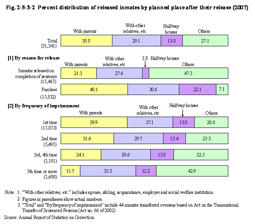| Previous Next Index Image Index Year Selection | |
|
|
2 Halfway houses As of April 1, 2008, there were 101 halfway houses nationwide (89 facilities for males, 7 facilities for females, and 5 facilities for both), with a capacity of 2,268 persons (1,802 male adults, 298 male juveniles, 124 female adults, and 44 female juveniles) (Source: The Rehabilitation Bureau, Ministry of Justice). All halfway houses are operated by juridical persons for offenders' rehabilitation. Fig. 2-5-3-2 shows the percent distribution of inmates released from penal institutions in 2007, by planned place after their release. Fig. 2-5-3-2 Percent distribution of released inmates by planned place after their release (2007) Among those who left halfway houses in FY2007, 25.6% returned to their workplaces, 25.2% to rented houses, and 14.7% to their relatives or close associates. The percent ratio by occupation at the time of leaving halfway houses was the highest for those engaged in labor service (53.1%), followed by those working in the service industry (7.0%), and in the sales industry (2.3%). The ratio of those unemployed was 29.1% (Source: The Rehabilitation Bureau, Ministry of Justice).Each halfway house has made efforts to enhance its treatment function, such as introducing Social Skills Training (SST) and education on the harmful effects of alcoholic drinks and drugs. In FY2007, 38 halfway houses implemented SST and 27 implemented education on the harmful effects of alcoholic drinks and drugs (Source: The Rehabilitation Bureau, Ministry of Justice). |
